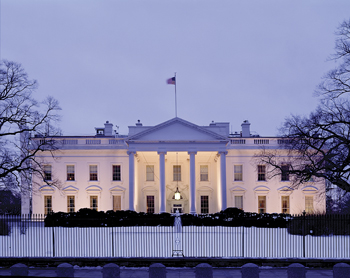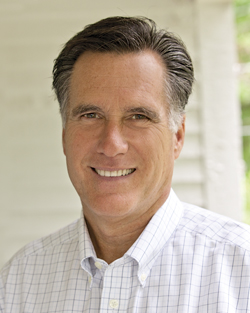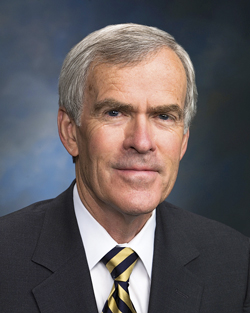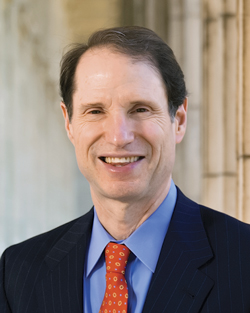ROGER H. BEZDEK, Contributing Editor, Washington
 |
| Whichever nominee wins The White House, it will have significant implications for the future of the U.S. oil and gas industry. |
|
In next month’s U.S. election, the Presidency is at stake, all 435 members of the House of Representatives are up for election, and one-third of the 100 U.S. Senators face election. The Republicans control the House, and the Democrats control the Senate. While Republicans will likely retain control of the House, the election could change control of the Senate. Republicans need to gain three seats to control the Senate—if Republican challenger Mitt Romney defeats President Obama—and four if Obama wins (the Vice President breaks any tie votes in the Senate).
The party that controls each branch will also control the congressional energy and environmental committees, and thus dictate proposed legislation. The two parties’ energy agendas differ significantly, so the election has major energy policy implications. This analysis focuses on potential oil and gas implications, notes differences in the energy planks of the parties’ platforms, summarizes the competing energy visions of President Obama and Mitt Romney, and discusses the implications of control of important congressional committees.
THE PARTY PLATFORMS
 |
| The future of hydraulic fracturing, like this job done by Sitter Drilling in West Virginia, appears assured if Republicans capture the White House, but it could face a tortuous path, if Obama wins a second term. Photo courtesy of Sitter Drilling. |
|
The Democratic and Republican energy platforms are not binding on the nominees. They differ significantly on policies affecting fossil fuels and the environment. Republicans would rely on fossil fuel development and business-friendly regulation. Democrats promote allocation of resources between fossil fuels and renewables, in addition to “green” initiatives.
With respect to fossil fuels, the Republican platform:
-
Supports “new, state-of-the-art coal-fired plants,” as well as “encouraging R&D for coal-to-liquid, coal gasification, and related technologies for EOR
-
Supports approval of the Keystone XL pipeline
-
Promotes gas, oil and coal development, on and offshore
-
Recommends expanded drilling off the East Coast, and opening all the Outer Continental Shelf (OCS) and the Arctic National Wildlife Refuge (ANWR)
-
Will deliver energy independence, employment and manufacturing through greater fossil fuel development
-
Supports “clean coal,” and advocates natural gas usage
-
Supports expediting “the approval process to build out critical oil and gas lines.”
Regarding fossil fuels, the Democratic platform:
-
Supports “preserving sensitive public lands from exploration, like ANWR, the Pacific West Coast, Gulf of Maine, and other irreplaceable national landscapes”
-
Pledges to eliminate subsidies to “Big Oil.”
On climate change, the Republican platform:
-
Contends that climate change is not yet understood
-
Would restore scientific integrity to public research institutions, implying that federal climate research is biased
-
Opposes “any and all cap-and-trade legislation.”
Regarding climate change, the Democratic platform:
-
Calls climate change “one of the biggest threats of this generation”
-
Would address domestic emissions through “regulations and market solutions”
-
Would show “international leadership on climate change.”
On energy-related regulation, the Republican platform:
-
Would “rein in the EPA,” whose rules are “creating regulatory uncertainty, preventing new projects from going forward”
-
States that “federal agencies charged with enforcing environmental laws must stop regulating beyond their authority”
-
Pledges that “the Republican Party supports appointing public officials to federal agencies, who will properly and correctly apply environmental laws and regulations”
-
Would require more EPA transparency and have Congress prohibit it from “moving forward with new GHG regulations”
-
Would “respect the states’ proven ability to regulate the use of hydraulic fracturing” and “restore the authority of states in environmental protection.”
Concerning energy-related regulation, the Democratic platform supports:
-
Recent EPA rules and regulation of air pollutants
-
“Emissions and fuel efficiency standards”
-
“Safeguards” to protect against potential damage from natural gas development.
THE OBAMA ENERGY PLAN
 |
| President Barack H. Obama |
|
President Obama’s energy plan, Blueprint For a Secure Energy Future, was released on March 30, 2011, and updated in a March 2012
Progress Report. His plan outlines a three-part strategy:
Develop and secure America’s energy supplies. The plan advocates expanding safe, responsible oil and gas development and production. The administration contends that it has made structural reforms within the Department of the Interior (DOI) to improve oversight while encouraging exploration of new production frontiers, and safely finding new ways to use domestic assets, such as natural gas. The plan recommends reducing oil demand and increasing reliable oil supplies, worldwide, while diversifying the fuel mix in U.S. vehicle fleets. The administration wants to reduce oil demand through efficiency, technology and conservation.
Provide consumers with choices to reduce costs and save energy. The plan advocates reducing costs at the pump with more efficient cars and trucks. The administration is implementing new fuel economy standards for cars and trucks, to average 35.5 mpg by 2016. The plan’s ambitious goal is that, by 2015, the U.S. would have 1 million electric vehicles on the road. To “reduce energy bills,” the plan advocates creating a new industry to make homes, buildings and factories more energy-efficient. This involves various programs, like weatherizing homes for lower-income Americans; the HOMESTAR program, to help homeowners finance retrofits; a “Better Buildings Initiative,” to make commercial facilities 20% more efficient by 2020; and steps to promote industrial efficiency.
Create markets for innovative, clean technologies, and fund research for the next generation of technologies. Obama proposes, by 2035, to generate 80% of U.S. electricity from “clean” energy sources, including renewables; nuclear power; natural gas; and clean coal. A Clean Energy Standard would encourage investors to funnel billions of dollars into these energy forms, creating jobs and reducing air pollution and GHG emissions. Obama signed an Executive Order that makes it every federal agency’s responsibility to help move the nation toward a clean energy economy. His plan announced new steps to improve the federal fleet’s performance, so that it is composed entirely of alternative fuel vehicles.
The March 2012 Progress Report summarized what it contended were Obama’s major energy policy successes, while claiming that his strategy has had an impact:
-
U.S. oil output has increased for the past three years. In 2011, it was 5.6 million bopd, its highest level since 2003.
-
Since 2009, the U.S. has been the world’s leading natural gas producer, with 2011 output exceeding the 1973 record.
-
Oil imports have fallen since 2005, and, as a share of total consumption, declined from 57% in 2008 to 45% in 2011, the lowest level since 1995.
-
Obama has put in place the first-ever fuel economy standards for heavy-duty trucks, and the toughest standards for passenger vehicles in history, at 54.5 mpg by 2025.
-
By 2015, the U.S. will be able to produce enough batteries and components to support the manufacture of one million plug-in hybrid and electric vehicles.
-
Made the largest clean energy investment in history, and has doubled renewable energy generation since 2008.
-
Since October 2009, DOE and the Department of Housing and Urban Development have completed energy upgrades in 1 million homes.
THE ROMNEY ENERGY PLAN
 |
| Former Governor W. Mitt Romney |
|
Mitt Romney’s energy plan, The Romney Plan For a Stronger Middle Class: Energy Independence, was released on Aug. 23, 2012. Romney’s plan would:
-
Empower states to control onshore energy development
-
Open offshore areas for development
-
Pursue a North American Energy Partnership, working with Canada and Mexico to achieve energy independence
-
Ensure accurate assessment of energy resources
-
Restore transparency and fairness to permitting and regulation
-
Facilitate private sector development of technologies.
One of Romney’s goals is to achieve North American energy independence by 2020. “While every President since Nixon has tried and failed to achieve this goal,” said Romney, “analysts across the spectrum now recognize that surging U.S. energy production, combined with the resources of America’s neighbors, can meet all of the continent’s energy needs within a decade. The key is to embrace these resources and open access to them.” Romney wants to turn the U.S. into an energy superpower that generates numerous benefits:
-
More than 3 million new jobs; 1 million in manufacturing
-
An economic resurgence, adding $500 billion-plus to GDP
-
A stronger dollar and reduced trade deficit
-
More than $1 trillion in revenue for federal, state and local governments
-
Lower energy prices
-
National security strengthened by freedom from dependence on foreign energy.
Romney contends that his plan will result in resurgent American manufacturing; a long-term competitive advantage for U.S. industry, thanks to lower costs; and millions of new jobs, upstream, and downstream, in industries that can utilize the output.
The Romney plan states that “President Obama has intentionally sought to shut down oil, gas and coal production in pursuit of his own alternative energy agenda.” To remedy this, Romney would increase access to Federal lands, and empower states to control onshore development:
-
States can establish oversight of development and production of all energy forms on federal lands within their borders
-
State regulatory processes and permitting for all forms of energy development will satisfy federal requirements
-
Federal agencies will certify state processes as adequate, according to established, sufficiently broad criteria
-
The federal government will encourage formation of a State Energy Development Council, where states work together to share expertise and best management practices.
The Romney plan contends that “Since day one, the Obama administration has worked systematically to shut down development of the OCS.” Romney will open offshore areas and:
-
Establish a new five-year offshore leasing plan that opens new areas for development, beginning offshore Virginia and the Carolinas
-
Set minimum production targets for each five-year leasing plan, requiring annual reports to Congress on progress in reaching goals, and implementing new policies to compensate for any shortfall
-
Guarantee that new processes and safeguards for offshore drilling are implemented to support, not block, E&P.
Romney criticizes Obama for “turning his back on America’s neighbors by rejecting the Keystone XL pipeline.” Noting that North
America is the world’s fastest-growing oil and gas-producing region, Romney will pursue an energy partnership by:
-
Approving the Keystone XL pipeline
-
Establishing a regional agreement to facilitate cross-border energy investment, infrastructure and sales
-
Promoting and expanding regulatory cooperation between governments to encourage responsible energy production
-
Instituting fast-track approval for cross-border pipelines.
Romney believes that Obama has used inaccurate information to assess America’s energy resources and confused the difference between “proved” and “recoverable” reserves to argue incorrectly that these resources are scarce. For a more realistic picture, a Romney administration will:
-
Approve permits for seismic surveys and exploration offshore, to update decades-old information
-
Require the sharing of onshore geological and geophysical information with DOI
-
Undertake new seismic analyses in offshore areas not included in the new lease plan
-
Collaborate with Canada and Mexico, to ensure accurate inventory of their resources and sharing of data.
Romney contends that regulations designed to protect public health and the environment have, instead, been seized on by environmentalists as tools to stop development, an approach embraced by Obama. To remedy this, his plan would:
-
Reform environmental statutes and regulations to strengthen environmental protection without destroying jobs, paralyzing industry, or barring resource usage
-
Improve environmental reviews by setting deadlines and limitations, requiring better coordination between agencies, and allowing state reviews to satisfy federal requirements
-
Prevent agencies from using closed-door, “sue-and-settle” techniques to circumvent public rulemaking
-
Disclose federal funds spent reimbursing groups for lawsuits against the government
-
Repeal the new vehicle fuel efficiency standards.
Romney says that Obama’s poor understanding of the private sector has distorted energy policy, as he spent billions of dollars subsidizing risky companies and technologies. Romney will foster private sector development of new technologies by:
-
Focusing governmental investment on research across all energy technologies
-
Supporting increased market penetration and competition among energy sources
-
Ensuring that greater development applies to all energy forms.
The Romney plan’s emphasis on oil and gas is clear.
ASSESSMENT OF THE TWO PLANS
Both plans are, obviously, political documents designed to facilitate election of their respective candidates. Both plans contain disingenuous or inaccurate elements.
Obama’s plan. President Obama correctly states that the U.S. has reduced energy imports and expanded domestic energy production. Yet, the relevant question is whether this progress is the result of his policies and actions, or whether he is merely taking credit for changes achieved by U.S. companies. Perhaps more relevant, are these trends because of, or in spite of, his policies?
Energy production has increased, because high oil prices have rendered it profitable to do so, but this has had little to do with Obama’s policies. Advances in horizontal drilling and fracing made it possible for many more firms to participate in onshore shale E&P. These firms took risks that paid off in the shales. Similarly, high natural gas prices several years ago drove the E&P focus on gas development. This resulted in a gas glut and lower prices. All these trends predate Obama’s election. Even his plan notes that U.S. oil imports have been falling since 2005.
Obama’s new vehicle efficiency standards will radically change the vehicles that Americans drive, to reduce gasoline consumption and encourage the use of plug-in hybrid electric vehicles—whether consumers like it or not. While Toyota’s Prius has been a success, forcing a bailed-out General Motors to produce the Chevy Volt has been risky. Consumers seem to have decided that there are better values for $40,000. As consumers find standard options disappearing (spare tires are being eliminated to save weight, and SUVs may eventually disappear), the enhanced fuel standards may become less appealing. More importantly, the U.S. National Academies of Science found that small, lighter, fuel-efficient vehicles are less safe and crash-worthy.
Further, a key part of Obama’s energy strategy is to eliminate “subsidies for Big Oil.” However, he has never precisely defined what “Big Oil” means (large companies and not small companies?). More importantly, he has not identified unique subsidies to the oil industry, as opposed to standard tax code provisions that apply to all companies in all industries.
 |
| Gov. Romney’s plan would accelerate development of shale plays, like this ConocoPhillips wellsite in the Eagle Ford shale of Texas. |
|
The Romney plan. A key feature of Romney's plan is to turn over decision-making on drilling and mining to the states. Giving states control over resources on millions of acres of federal lands might be politically difficult, and represents a radical shift from a century of policies. Democrats are quick to say that this could create 50 different sets of rules and regulations, and that “Balkanization” of rulemaking could cause problems.
To be fair, the industry already deals with specific oil and gas agencies (like the Texas Railroad Commission) in several dozen states. These agencies already supervise thousands of field operations on state and private lands. It would not be such a terrible stretch to extend this supervision to federal lands. Further, almost all the shale gas and tight oil is on private and state lands. Thus, giving the states rights to open federal land within their boundaries may change little. However, it is difficult to envision federal officials ceding offshore control to the states.
As with Obama’s plan, some of Romney’s statements are factually challenged. For example, at his plan’s unveiling, Romney said that the U.S. "produces about 15 million bopd, about two-thirds of the country's total demand." In reality, the U.S. is producing 6.2 million bopd and consuming 18.7 million bopd.
Also, Romney states that achieving North American energy independence would reduce the U.S. trade deficit. However, oil imports from Mexico or Canada would have the same impacts on the trade deficit as imports from Saudi Arabia, Venezuela, etc. Romney’s goal of North American energy independence by 2020 is very ambitious, and may only be achievable by 2030. Nonetheless, there is little doubt that Romney’s energy plan is much more oil-and-gas-friendly than Obama’s strategy.
  color.jpg) |
| Sen. Jeff Bingaman (Dem.-N.M.), chairman of the Senate Energy and Natural Resources Committee (left), is retiring. If the Democrats keep control of the Senate, then Sen. Ron Wyden (Dem.-Ore.) is likely to be the next chair (center). If the Republicans gain control, then Sen. Lisa Murkowski (Rep.-Alaska) is in line to be chair (right). |
|
SENATE ENERGY AND NATURAL RESOURCES COMMITTEE
The Senate Committee on Energy and Natural Resources (E&NR) oversees some of Congress’ most important energy legislation. Its extensive authority includes energy resources and development; nuclear energy; Indian affairs; public lands and their renewable resources; surface mining, federal coal, oil, gas and other mineral leasing; territories and insular possessions; and water resources. The committee has 11 Democrats, 10 Republicans and one Independent. E&NR has four sub-committees.
The committee chair is Jeff Bingaman (Dem.–N.M.), and the Ranking Minority Member is Lisa Murkowski (Rep.–Alaska). However, Bingaman is retiring and, if the Democrats retain control of the Senate, he will be replaced by Sen. Ron Wyden (Dem. – Ore.). If the Republicans gain control, Murkowski will chair the committee. E&NR is generally a constituent-oriented committee, with a Western emphasis. Because the issues considered affect regional more than partisan interests, the panel has traditionally taken a consensus approach to its work.
Wyden, next in line in seniority among Democrats, advocates repealing oil industry “subsidies,” curbing oil market speculation, and opposing ANWR drilling. However, he has a history of working amiably with Republicans on energy and resource issues. Wyden also sits on the Senate Finance Committee and is interested in the tax aspects of encouraging more redevelopment of existing oil wells and fields.
Sen. Murkowski is a moderate Republican and the only GOP senator from any West Coast state. If she becomes committee chair, she will be a moderate, bipartisan consensus-builder. In 2010, she lost the GOP primary to a conservative “Tea Party” Republican and had to run in the general election as an Independent write-in candidate. She prevailed (even with the Herculean task of getting enough voters to write in “Murkowski”) and won re-election, thus becoming the first senator to win a write-in campaign in over a half-century. Since winning re-election, her voting record has become more moderate.
If Murkowski becomes E&NR chair, it could have major, positive implications for oil and gas. She supports efforts to drill in ANWR, as well as expand offshore drilling. Murkowski believes that recent technological developments make it possible to drill with minimal environmental damage, despite the 2010 Deepwater Horizon oil spill. She introduced a bill that would block the EPA from limiting the amount of GHGs that major industries can produce, stating that "We cannot turn a blind eye to the EPA's efforts to impose back-door climate regulations with no input from Congress." She opposes GHG measures and EPA actions on CO2.
Wyden is full of contrasts. He opposes barring EPA from regulating GHGs, supports GHG cap-and-trade legislation, and wants to address CO2 emissions without considering India & China. On the other hand, he opposes a national energy tax and supports tax incentives for energy production and conservation. He cancels that out by opposing oil and gas exploration write-offs and other “unwarranted tax breaks and subsidies (for) Big Oil,” while also opposing E&P in ANWR. He also supports making oil cartels illegal, factoring global warming into federal project planning, and imposing fuel efficiency standards.
Various conservative and liberal organizations rate members of Congress on their voting records, and one of these is the liberal Campaign for America’s Future (CAF). On energy issues, CAF gives Sen. Wyden a 100% rating and Sen. Murkowski a 0% rating.
HOUSE ENERGY AND COMMERCE COMMITTEE
The Committee on Energy and Commerce (E&C), the oldest standing legislative committee in the House of Representatives, has the broadest jurisdiction of any congressional authorizing committee. It has responsibility for telecommunications; consumer protection; food and drug safety; public health research; environmental quality; energy policy; and interstate and foreign commerce. It also oversees multiple departments and agencies, including DOE, Health and Human Services; Commerce; and Transportation; as well as EPA; the Federal Trade Commission; the Food and Drug Administration; and the Federal Communications Commission. Clearly, with oversight of DOE and EPA, this committee is crucially important for oil and gas.
The current Republican chair is Fred Upton (Rep.-Mich.), and the ranking minority member is Henry Waxman (Dem.-Calif.). The full committee has 31 Republicans and 23 Democrats. It has six subcommittees. While the Senate E&NR Committee may be relatively bipartisan, the same cannot be said of the House E&C Committee. Upton is a conservative Republican, while Waxman is one of the most liberal Democrats.
Upon assuming the E&NR committee chair in 2011, Upton stated that “The Obama administration is on notice—they will not be allowed to regulate what they have been unable to legislate.” He quipped that EPA Administrator Lisa Jackson would be testifying at oversight hearings so often that she should reserve a personal parking place on Capitol Hill. True to his word, E&C over the past two years has held numerous hearings, relentlessly grilling Jackson and other top EPA officials over all aspects of EPA energy regulations. Similarly, E&C very actively investigated the Solyndra debacle.
Upton is clear about E&C’s direction, if he remains the chair. He wants to pass measures to accelerate energy development by cutting through red tape. Second, he feels that the U.S. need not stifle resource development to protect the environment. He cites horizontal drilling technology, where a single borehole replaces several wells, and new oil and gas pipelines employing state-of-the-art technology that did not exist a few years ago. Third, he feels that the U.S. needs an “all may compete” energy policy that does not vilify certain types of energy, such as fossil fuels. Finally, he recommends that the U.S. reduce barriers to responsible development. Approving items like the Keystone XL pipeline and streamlining the permitting process for projects are two examples. Upton supports opening all the OCS and ANWR to drilling. He naturally opposes pro-“green,” pro-GHG-regulating measures. On energy, CAF rates Upton at 17%.
Waxman is a stark conrast to Upton. During 2009–2010, he was E&C chair. From 1979 to 1994, he chaired the E&C Subcommittee on Health and the Environment, and served as its Ranking Member in 1995 and 1996. He is an unabashed, unapologetic liberal, a strong environmentalist, and no friend to oil and gas. Waxman favors carbon and gasoline taxes to reduce the federal budget deficit. In 2009, when he was E&C chair, Waxman convinced the House to (just barely) pass the American Clean Energy and Security Act of 2009, which, fortunately, did not pass the Senate. It would have imposed a GHG cap-and-trade regime on the U.S., and it would have been one of the most intrusive, anti-fossil fuel laws ever enacted.
Waxman has characterized Republican energy policy as a “monstrosity,” a “Trojan horse,”and an “all-out assault” on the environment. He contends that House Republicans are the most anti-environmental group in the history of Congress, that they are “getting away—literally—with murder.” Waxman also said that Mitt Romney’s energy plan “is just more of the same oil-above-all agenda.” He also sarcastically commented, “It shows as much ignorance of science as (Missouri GOP Senate candidate) Todd Akin's understanding of pregnancy.”
Waxman pretty much opposes anything favorable to oil and gas, while favoring a very “green”, pro-EPA, pro-GHG regulations agenda. On energy, CAF rates Waxman at 100%.
CRITICAL CONGRESSIONAL RACES
.jpg) |
| Rep. Fred Upton (Rep.-Mich.) appears safely headed toward another two years as chairman of the House Energy and Commerce Committee. |
|
As noted, Democrats need to pick up at least 25 seats in the House to regain control. However, that possibility is remote. Thus, the House E&C Committee will likely remain firmly in Republican control with Upton as chairman; his congressional seat is safe. The Republicans have a better chance of gaining control of the Senate. They need to pick up four seats. Significantly, of the 32 Senate seats in play this year, Republicans hold 10, while the Democrats are defending 22.
Nevertheless, a strange thing may be happening to GOP prospects for organizing the Senate next year. The Republican Senate takeover that most analysts thought was almost a sure thing earlier this year now appears to be, at best, a toss-up. This is the result of an unexpected Republican retiring in Maine, a potentially fatal gaffe by the Republican candidate in Missouri, and weaker Republican candidates and stronger Democratic nominees than expected in several states. The situation is much more fluid than anyone expected, and control of the Senate next year will depend on outcomes in about a dozen states.
.jpg) |
| Rep. Henry Waxman (Dem.-Calif.) is Ranking Member on the House Energy and Commerce Committee, and is antithetical to just about everything oil and gas. His 2009-2011 tenure as committee chairman is a “nightmare” that the industry does not want to see repeated. |
|
Connecticut is one of the biggest surprises. In this heavily Democratic state, Republican nominee Linda McMahon, a former professional wrestling executive, lost the race for an open Senate seat two years ago by a landslide, despite spending huge amounts of her own money. Nevertheless, in this race to replace retiring Sen. Joe Lieberman (an Independent caucusing with the Democrats), she is surging in the polls, and the race may become competitive. McMahon’s Democratic opponent, Rep. Chris Murphy, lacks a statewide profile. Further, Murphy is plagued by revelations that he has failed to pay his mortgage and rent in the past. He also suffers from a 5-to-1 campaign spending gap. Connecticut has changed from solidly Democratic to likely Democratic.
Indiana will likely deliver a strong Romney majority. However, state Treasurer Richard Mourdock, a Tea Party favorite, defeated Sen. Richard Lugar in a bitter Republican primary for a seat that Lugar had held since the mid-1970s. Since then, Mourdock has struggled, and his Democratic opponent, Rep. Joe Donnelly, has gained popularity, drawing support from some of Lugar’s backers and outspending Mourdock on advertising. Mourdock has begun a tactical shift to the center, temporizing some of his positions and contending that he can work with members of both parties. Yet, he continues to stumble. Donnelly will have to rely on support from conservative Democrats, independents and disaffected Republicans, who despise Obama but who might dislike some of Mourdock’s positions. This race has changed from solidly Republican to likely Republican.
Maine. Long-serving Republican Sen. Olympia Snowe’s surprise retirement announcement earlier this year almost certainly removed a safe seat from the GOP column. Former Gov. Angus King is running as an Independent and is strongly favored. He will likely caucus with the Democrats.
Massachusetts is heavily Democratic and should give Obama a large majority. Democrats had expected to defeat incumbent Republican Sen. Scott Brown. They have a strong candidate in Elizabeth Warren, a Harvard University professor and creator of the Federal Consumer Financial Protection Bureau. She has raised record amounts of money, but has been unable to pull away from Brown, who may be the most moderate/left Republican in the Senate, and whose personal appeal is strong among voters. Brown could run a flawless campaign and still lose, if Obama’s margin is large. The state remains a toss-up.
Missouri. Until August, this was a likely Republican pick-up, and incumbent Democratic Sen. Claire McCaskill was vulnerable. Then, her Republican opponent, Todd Akin, gave an infamous interview, where he made the biologically ludicrous statement that women who were “legitimately raped” could not get pregnant. The interview went viral, and the entire Republican establishment (fearful of alienating female voters) unloaded on Akin and urged him to exit the race. He refused, and Republican national organizations stopped funding him. McCaskill is thus the favorite. Unless Akin leaves the race and is replaced by someone more electable, this seat will remain Democratic.
Montana is in play, although few expected it. Incumbent Democratic Sen. John Tester was viewed as vulnerable, and the state will likely give Romney a large majority of its votes. Nevertheless, Republican Rep. Denny Rehberg is struggling, whereas Tester has run a nearly flawless campaign. The state is a toss-up.
New Mexico. Republicans originally had high hopes for gaining the Senate seat held by popular, retiring Democratic incumbent Jeff Bingaman (current Senate E&NR chair). They fielded a moderate veteran candidate, former Rep. Heather Wilson, but the race appears to be slipping away from her. Wilson seems to be getting little help from Romney. What once looked like an even match-up with the Democratic candidate, Rep. Martin Heinrich, now appears to be a Democrat lock. The National Republican Senatorial Committee has canceled advertising there, to shift resources elsewhere.
North Dakota was originally thought to be an easy Republican pick-up, since incumbent Democratic Sen. Kent Conrad is retiring, the state leans Republican, and Romney should carry the state strongly. However, the Democratic candidate, former North Dakota Attorney General Heidi Heitkamp, has unexpectedly run a strong, competitive campaign. Her Republican opponent, Rep. Rick Berg, is struggling. In a state that should have been safely wrapped up for the GOP, Berg cannot open a lead over Heitkamp, who has not been on a statewide ballot in 12 years. In recent months, the state has gone from “solidly Republican,” to “likely Republican,” to “toss-up.”
Wisconsin. Democrats had hoped to retain the seat being vacated by Sen. Herb Kohl, but former Republican Gov. Tommy Thompson is about even with Democratic Rep. Tammy Baldwin. Thompson, a longtime fixture in Wisconsin politics, has crossover appeal in this severely polarized state, but a bitter primary contest exhausted his campaign funds, so Baldwin has a significant funding advantage. Democrats contend that some Democratic voters do not know Baldwin, and that they only need to convince them to vote for her. However, the burden is still on Baldwin. The race remains very competitive and is a toss-up.
SWING STATES
Given the fluid nature of the races in many states, Senate control may ultimately be decided by the same swing states that may decide the Presidential race: Florida, Ohio and Virginia.
Florida Republican Rep. Connie Mack is running against Democratic Sen. Bill Nelson, who is vulnerable. However, Mack’s campaign got off to a slow start, and he trails Nelson in fundraising. Mack has been harmed by controversies surrounding his history of personal debt and bar fights. Further, Nelson has been vulnerable before, but has managed to somehow squeak through to victory. The race will depend on the Presidential results. At present, this race is rated as likely Democratic.
Ohio. Republican state Treasurer Josh Mandel is running against Democratic Sen. Sherrod Brown. A few months ago, Brown seemed far ahead, but a strong campaign and over $15 million worth of advertisements for Mandel have tightened up the race. Mandel has reduced Brown’s lead from double digits to single digits, but Brown remains the favorite. The outcome will depend on which Presidential candidate carries the state and by how wide a margin. This race leans Democratic.
Virginia. Former Republican Gov. and Sen. George Allen is running against former Democratic Gov. Tim Kaine for the seat of retiring Democratic Sen. Jim Webb. This race has consistently remained the closest in the nation. Both candidates are running good campaigns, and neither has been able to achieve a polling advantage outside the margin of error. The race is a dead heat and likely to remain so until the election. It may be decided by whether Obama or Romney wins. This race is a toss-up.
THE BOTTOM LINE
There is little doubt that the Republican energy agenda, as articulated by Mitt Romney and Republican leaders, is much more attractive to oil and gas than Democratic energy stands. On almost any major issue, Republican energy policies and priorities are much more closely aligned with the industry. It is highly likely that the Republicans will retain control of the House. Thus, oil and gas companies can take some comfort in that at least one branch of the government will have their concerns in mind.
However, the results of the election remain uncertain. Given the discussion above and the likelihood that the Senate and Presidential election results may be decided by the same small number of swing states, it is likely that the party that wins the White House will also win the Senate. The best result for the industry would be for Romney to win, and for the Republicans to win a Senate majority. If Obama is re-elected and the Democrats control the Senate, or even if Obama is re-elected and Republicans gain control of the Senate, U.S. energy policy is in for continued partisanship and gridlock, for at least another two years. 
The author
DR. ROGER BEZDEK is an internationally recognized energy analyst and president of Management Information Services, Inc., in Washington, D.C. He has 30 years’ experience in research and management in the energy, utility, environmental and regulatory areas, serving in private industry, academia and the federal government. He has served as senior adviser on energy in the Office of the Secretary of the Treasury, as U.S. energy delegate to the European Community and to NATO, and as a consultant to the White House. His most recent book, The Impending World Energy Mess, was published in October 2010. |
|








color.jpg)
.jpg)
.jpg)

